
Free Download Essential GraphRAG
by Tomaž Bratanič and Oskar Hane
English | 2025 | ISBN: 1633436268 | 216 pages | True/Retail EPUB | 7.48 MB
Upgrade your RAG applications with the power of knowledge graphs.
Retrieval Augmented Generation (RAG) is a great way to harness the power of generative AI for information not contained in a LLM's training data and to avoid depending on LLM for factual information. However, RAG only works when you can quickly identify and supply the most relevant context to your LLM.Essential GraphRAGshows you how to use knowledge graphs to model your RAG data and deliver better performance, accuracy, traceability, and completeness.
InsideEssential GraphRAGyou'll learn:
The benefits of using Knowledge Graphs in a RAG systemHow to implement a GraphRAG system from scratchThe process of building a fully working production RAG systemConstructing knowledge graphs using LLMsEvaluating performance of a RAG pipeline
Essential GraphRAGis a practical guide to empowering LLMs with RAG. You'll learn to deliver vector similarity-based approaches to find relevant information, as well as work with semantic layers, deliver agentic RAG, and generate Cypher statements to retrieve data from a knowledge graph.
About the technology
A Retrieval Augmented Generation (RAG) system automatically selects and supplies domain-specific context to an LLM, radically improving its ability to generate accurate, hallucination-free responses. The GraphRAG pattern employs a knowledge graph to structure the RAG's input, taking advantage of existing relationships in the data to generate rich, relevant prompts.
About the book
Essential GraphRAGshows you how to build and deploy a production-quality GraphRAG system. You'll learn to extract structured knowledge from text and how to combine vector-based and graph-based retrieval methods. The book is rich in practical examples, from building a vector similarity search retrieval tool and an Agentic RAG application, to evaluating performance and accuracy, and more.
What's insideEmbeddings, vector similarity search, and hybrid searchTurning natural language into Cypher database queriesMicrosoft's GraphRAG pipelineAgentic RAG
About the reader
For readers with intermediate Python skills and some experience with a graph database like Neo4j.
About the author
The author of Manning's Graph Algorithms for Data Science and a contributor to LangChain and LlamaIndex,Tomaž Bratanichas extensive experience with graphs, machine learning, and generative AI.Oskar Haneleads the Generative AI engineering team at Neo4j.
Table of Contents
1 Improving LLM accuracy
2 Vector similarity search and hybrid search
3 Advanced vector retrieval strategies
4 Generating Cypher queries from natural language questions
5 Agentic RAG
6 Constructing knowledge graphs with LLMs
7 Microsoft's GraphRAG implementation
8 RAG application evaluation
A The Neo4j environment
Recommend Download Link Hight Speed | Please Say Thanks Keep Topic Live
Uploady
onu7h.7z
Rapidgator
onu7h.7z.html
UploadCloud
onu7h.7z.html
Fikper
onu7h.7z.html
FreeDL
onu7h.7z.html
Links are Interchangeable - Single Extraction
